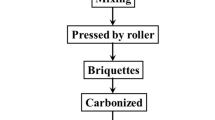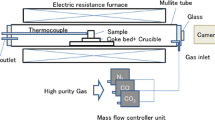Abstract
Identifying key factors governing the dissolution rate of metallurgical coke into liquid iron is important for sustainable developments of blast furnace iron-making. This study investigated the metallurgical coke dissolution into liquid iron by comparing the interfacial behavior between four carbonaceous materials and iron to clarify the influence of coke pore, carbon structure and ash. The wettability between coke and molten iron is reduced by the disorder of the carbon structure, and the presence of minerals can significantly reduce the rate of carburization with the dissolution breadth and depth of coke powder tablets reaching minimum values, 11 mm and 0.33 mm, respectively. The presence of pores significantly improves the dissolution rate, and the dissolution breadth and depth of coke slices increased to 16.5 mm and 0.97 mm, respectively. The main mechanism by which the pores accelerate the rate of metallurgical coke into the molten iron is to improve the contact area between the iron and the coke slices at high temperatures. The effect of the carbon structure and ash on the dissolution rate becomes weaker when there are pores in the coke.







Similar content being viewed by others
References
H.W. Gudenau, J.P. Mulanza, and D.G.R. Sharma, Steel Res. 61, 97 (1990).
B. Cusack, G. Hardie, and P. Burke, European Ironmaking Cong. Glasgow, 1991.
J. Keogh, G. Hardie, D. Philip, and P. Burke, AIME 50th Ironmaking Conference Proceedings, Washington, 1991.
M. Hallin, Ishii Symposium on Sustainable Ironmaking, CCSD, Sydney, Australia. 2006.
Y. Omori, Blast furnace phenomena and modelling. (Committee on reaction within blast furnace, 1987), pp. 98-124.
X. Wang, Metallurgy of Iron and Steel, Part I: Ironmaking, 2nd ed. (Beijing: Metallurgical Industry Press, 2013), pp. 36–42.
T. Murakami, M. Ohno, K. Suzuki, K. Owaki, and E. Kasai, ISIJ Int. 57, 1928 (2017).
C.S. Nguyen, K. Ohno, T. Maeda, and K. Kunitomo, ISIJ Int. 57, 1491 (2017).
K. Ohno, A. Babich, J. Mitsue, T. Maeda, D. Senk, and H.W. Gudenau, ISIJ Int. 52, 1482 (2012).
C. Wu, R. Wiblen, and V. Sahajwalla, Metall. Mater. Trans. B 31, 1099 (2000).
M. Chapman, Insoluble oxide product formation and its effect on coke dissolution in liquid iron, University of Wollongong, Doctoral Dissertation, 64 (2009).
S.T. Cham, R. Khanna, V. Sahajwalla, R. Sakurovs, and D. French, ISIJ Int. 49, 1860 (2009).
B.J. Monaghan, M.W. Chapman, and S.A. Nightingale, Steel Res. Int. 81, 829 (2010).
R. Khanna, V. Sahajwalla, B. Rodgers, and F. McCarthy, Metall. Mater. Trans. B 37, 623 (2006).
M.W. Chapman, B.J. Monaghan, S.A. Nightingale, J.G. Mathieson, and R.J. Nightingale, Metall. Mater. Trans. B 39, 418 (2008).
V. Sahajwalla and R. Khanna, Metall. Mater. Trans. B 31, 1517 (2000).
V. Sahajwalla and R. Khanna, Acta Mater. 50, 663 (2002).
F. McCARTHY, R. Khanna, V. Sahajwalla, and N. Simento, ISIJ Int. 45, 1261 (2005).
F. McCarthy, V. Sahajwalla, J. Hart, and N. Saha-Chaudhury, Metall. Mater. Trans. B 34, 573 (2003).
Y. Deng, J. Zhang, and K. Jiao, ISIJ Int. 24, 659 (2018).
K. Ohno, S. Miura, T. Maeda, and K. Kunitomo, ISIJ Int. 59, 655 (2019).
K. Li, R. Khanna, J. Zhang, Z. Liu, V. Sahajwalla, and T. Yang, Fuel 133, 194 (2014).
S. Gupta, D. French, R. Sakurovs, M. Grigore, H. Sun, and T. Cham, Prog. Energy Combust. Sci. 34, 155 (2008).
K. Li, J. Zhang, Z. Liu, M. Barati, J. Zhong, and M. Wei, Metall. Mater. Trans. B 46, 1104 (2015).
K. Li, J. Zhang, M. Sun, C. Jiang, Z. Wang, and J. Zhong, Fuel 225, 299 (2018).
M. Sun, J. Zhang, K. Li, K. Guo, H. Wang, and Z. Wang, Metall. Mater. Trans. B 49, 2611 (2018).
M. Sun, J. Zhang, K. Li, S. Ren, Z. Wang, and C. Jiang, JOM 71, 4305 (2019).
C.S. Nguyen, K. Ohno, T. Maeda, and K. Kunitomo, ISIJ Int. 56, 1325 (2016).
S.S. Gornostayev, T.M. Fabritius, O. Kerkkonen, and J.J. Härkki, Int. J. Miner. Metall. Mater. 19, 478 (2012).
K. Ohno, T. Maeda, K. Nishioka, and M. Shimizu, ISIJ Int. 50, 53 (2010).
Y. Sasaki, Y. Kashiwaya, and K. Tokuchi, Metall. Mater. Trans. B 31, 216 (2000).
M.W. Chapman, B.J. Monaghan, S.A. Nightingale, J.G. Mathieson, and R.J. Nightingale, Metall. Mater. Trans. B 42, 642 (2011).
R. Xu, J. Zhang, W. Wang, H. Zuo, Z. Xue, and M. Song, J. Iron. Steel Res. Int. 25, 298 (2018).
S.T. Cham, V. Sahajwalla, R. Sakurovs, H. Sun, and M. Dubikova, ISIJ Int. 44, 1835 (2004).
Acknowledgements
This work was part of a research project named “The dissolution behavior and carburizing ability of coke dissolution in hot metal” supported by the National Science Foundation of China [51774032], the National Key Research and Development Program of China [2017YFB0304300 & 2017YFB0304303], the National Science Foundation for Young Scientists of China (51804025), the Chinese Fundamental Research Funds for the Central Universities [FRF-TP-17-086A1].
Author information
Authors and Affiliations
Corresponding authors
Additional information
Publisher's Note
Springer Nature remains neutral with regard to jurisdictional claims in published maps and institutional affiliations.
Rights and permissions
About this article
Cite this article
Sun, MM., Zhang, JL., Li, KJ. et al. The Interfacial Behavior Between Coke and Liquid Iron: A Comparative Study on the Influence of Coke Pore, Carbon Structure and Ash. JOM 72, 2174–2183 (2020). https://doi.org/10.1007/s11837-020-04048-0
Received:
Accepted:
Published:
Issue Date:
DOI: https://doi.org/10.1007/s11837-020-04048-0




